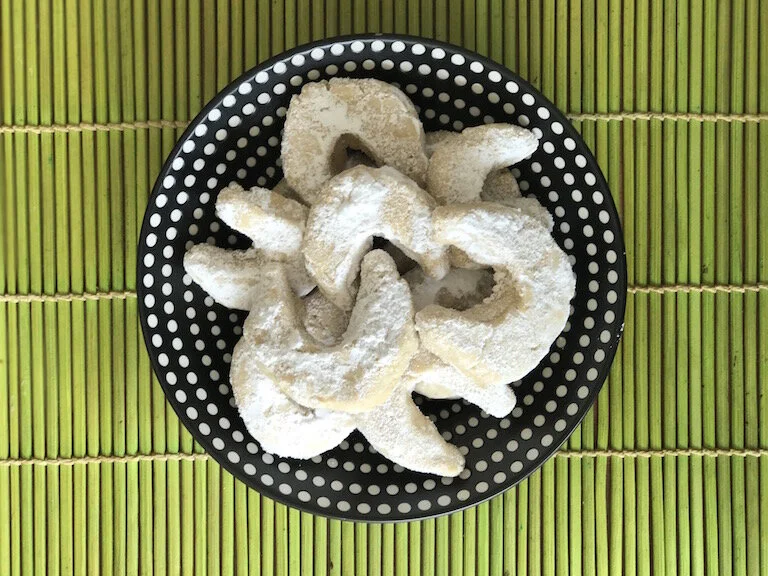How to Make your own Putri Salju Cookies
The Holy Month of Ramadan on the Islamic calendar is a period marked by the Five Pillars of Islam including Faith, Prayer, Charity, Fasting and Pilgrimage to Mecca. The Fasting Pillar refers to abstinence from food, drink smoking, gossip, swearing, sex and other sinful acts from sunrise to sunset. When the sun sets, the evening call to prayer is heard and this marks the breaking of the fasting period. This is known as ‘buka puasa’ (meaning ‘opening’ of the fasting period).
The first meal after fasting is known as ‘Iftar’ and usually consists of light snacks such as dates, cool drinks and even sweet tea. An assortment of biscuits are also enjoyed including today’s feature cookie, *Kue putri salju.
Kue putri salju are one of the more popular traditional biscuits of Indonesia, with origins in Europe. They are a type of ‘kue kering’, meaning dry cake or ‘biscuit’ and are typically crescent-shaped and coated with icing sugar (‘salju’ or snow). Most commonly enjoyed during festive times such as Eid-ul Fitr, these biscuits are a family favourite, especially amongst Indonesian children. Putri salju cookies are also enjoyed during Imlek (Chinese New Year) as well as Natal (Christmas).
Typically sold in plastic air tight containers or glass jars, you can find these delicacies at bakeries, supermarkets and traditional pasars too. But..! Why would you buy them when they are so easy to make? Today we share with you our recipe for kue putri salju. The biscuits are light and tasty with hints of roasted peanut and our added secret ingredient (lemon zest.. the secret is out!)
Traditional biscuit assortment sold at a local supermarket in Jakarta
So, put on your apron and get cracking (2 eggs required!) You’ll be super-pleased with the results and we are certain that your family and friends will be happy to sample your cookies too!
How to Make your own Putri Salju Cookies
Ingredients
225 gram butter (softened and chopped into cubes)
80 gram Caster sugar
2 egg yolks
2 tsp vanilla extract
200 gram plain flour
50 gram corn starch
1/2 tsp baking soda
50 gram milk powder
200 gram roasted peanut meal* or almond meal
2 - 3 tsp lemon rind (optional)
Icing sugar for dusting
Preparation
(*If using whole nuts, Dry roast them in a frypan first until they turn a light golden brown. Allow to cool then add to food processor and process until fine meal is formed)
Unroasted peanuts from local supermarket
Dry roasting the peanuts
Process to a fine meal in the food processor
Peanut meal
Method
1. Set the oven at 160 degrees celsius
2. Line two baking sheets with baking paper
3. Into a mixing bowl sift plain flour, corn flour, baking soda and milk powder. Mix to combine thoroughly.
4. Next, into your electric mixing bowl, cream butter and caster sugar. Mix on a medium /high speed until smooth and lighter in colour.
Cubes of quality butter and caster sugar in mixing bowl
Cream butter and sugar to form a light texture
5. To the butter mixture, add the egg yolks, vanilla extract and lemon rind and continue mixing at a medium speed until completely combined.
6. Into the butter mixture, add the flour mixture as well as the peanut meal.
7. Using a spatula, mix together, ensuring all ingredients are combined but not over-mixed.
8. Form mixture into a ball and place in bowl, covered with cling wrap. Refrigerate for 30 minutes.
9. Onto a well floured surface, roll mixture to a 1cm thickness and cut into crescent-shaped cookies (or whatever shape you like!). If you wish to form your cookies into crescent shapes and do not have a cutter, you can achieve this by hand. Simply divide cookie dough into equal spoon-sized balls and mould into crescent shape, flattening to 1cm thickness. Use plenty of flour to avoid dough sticking to surface.
10. Place on baking sheet, allowing space for spreading.
11. Bake in oven for 10-15 minutes or until golden.
12. Remove from oven and allow to cool on baking tray until firm.
13. Once completely cooled, sprinkle with icing sugar; or if you would like a more complete covering of sugar, dip each biscuit into a bowl of icing sugar.
14. Store in an airtight container or serve with a cup of coffee or your drink of choice.
Cook’s Notes:
To make cookie dough easier to work with, divide in half and leave one portion in the fridge whilst preparing the other half for the oven.
Traditionally these cookies are crescent-shaped but can be cut/shaped into any form you like. Just ensure all cookies are the same size to guarantee even baking
We have added lemon zest to give these cookies an extra-refreshing zing - but this is optional
We have used peanut meal as peanuts (“kacang tanah”) are easy to find in Indonesia. If you prefer you can use almond-, hazelnut- or cashew meal
Biscuits are often given as gifts during special times of the Year. Why not wrap these cookies in cellophane and tie with a pretty ribbon. They make a lovely gift for Eid-ul Fitr - or any other time of the year too!
Other traditional Indonesian cookies you might like to try include: Kue Nastar, Kaastengel (Cheese cookies of Dutch origin), Kue Semperit and Lidah Kucing (“Cat’s tongue”).
*Putri salju in Bahasa Indonesia means "snow princess”
If you enjoyed today’s post, we think you will also like the following:
In Pictures - Ramandan preparations in Jakarta
Ramadan and Eid-ul Fitr in Jakarta
Traditional cakes and sweets of Indonesia
Words: Jo Stevens Photography: a journey bespoke





























